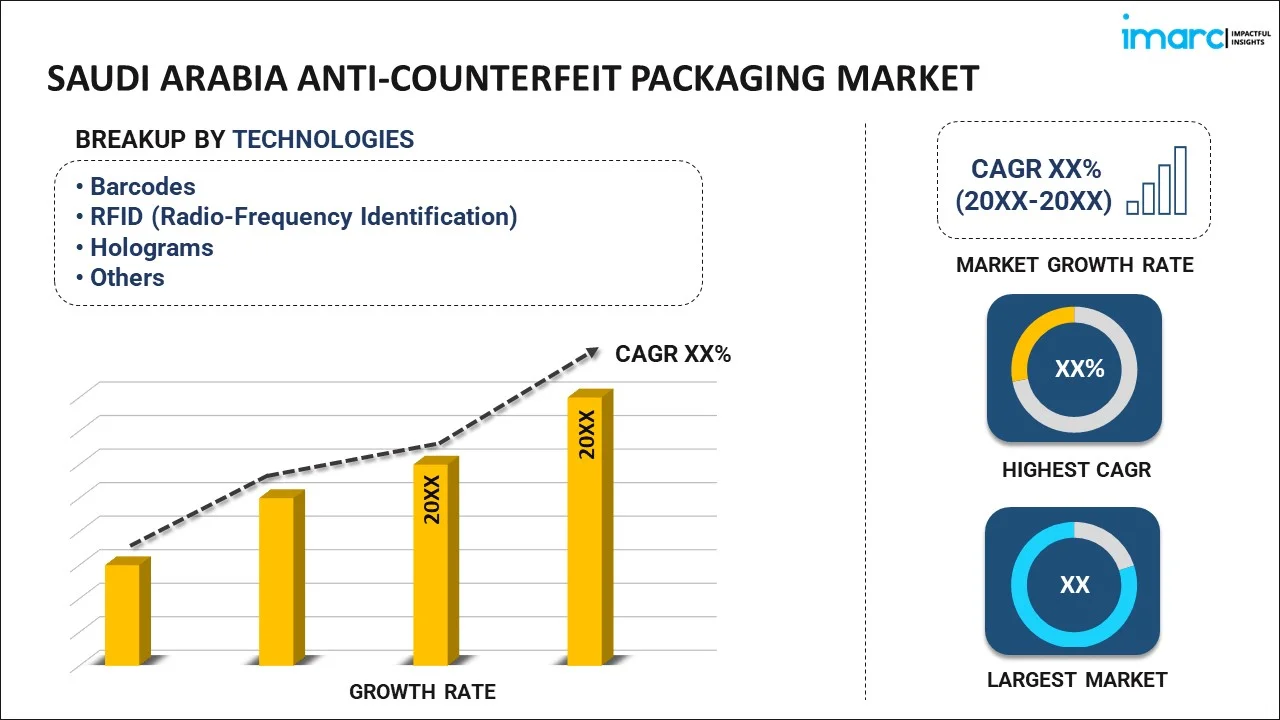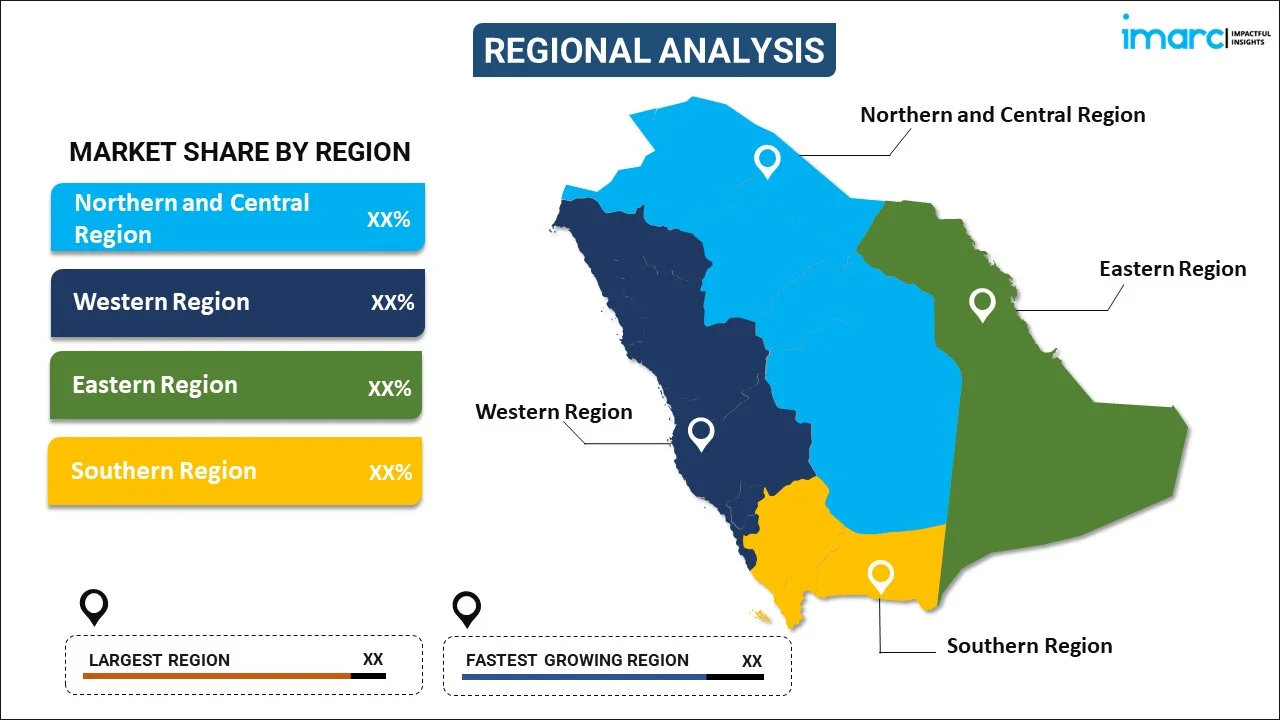
Saudi Arabia Anti-Counterfeit Packaging Market Report by Technology (Barcodes, RFID (Radio-Frequency Identification), Holograms, Taggants, and Others), Feature Type (Overt Features, Covert Features), End Use Industry (Food and Beverage, Healthcare, Automotive, Consumer Electronics, and Others), and Region 2025-2033
Market Overview:
Saudi Arabia anti-counterfeit packaging market size reached USD 1,270.6 Million in 2024. Looking forward, IMARC Group expects the market to reach USD 3,210.3 Million by 2033, exhibiting a growth rate (CAGR) of 10.8% during 2025-2033. The proliferation of counterfeit goods across various industries, including pharmaceuticals, food and beverages, electronics, and luxury goods, which has led to an increased demand for anti-counterfeit packaging, is driving the market.
|
Report Attribute
|
Key Statistics
|
|---|---|
|
Base Year
|
2024 |
|
Forecast Years
|
2025-2033
|
|
Historical Years
|
2019-2024
|
| Market Size in 2024 | USD 1,270.6 Million |
| Market Forecast in 2033 | USD 3,210.3 Million |
| Market Growth Rate (2025-2033) | 10.8% |
Anti-counterfeit packaging refers to the incorporation of security features in product packaging to prevent imitation and unauthorized reproduction of goods. It employs advanced technologies and methods to safeguard products and their packaging from being fraudulently copied or altered. These measures can include holograms, QR codes, RFID tags, tamper-evident seals, and unique identifiers. The primary goal is to authenticate products, ensuring consumers receive genuine items while protecting brands from revenue loss and reputational damage. Anti-counterfeit packaging not only deters counterfeiters but also aids in tracking and tracing products throughout the supply chain. This proactive approach enhances consumer confidence, supports regulatory compliance, and helps combat the issue of counterfeit goods, ultimately safeguarding both businesses and consumers.
Saudi Arabia Anti-Counterfeit Packaging Market Trends:
The anti-counterfeit packaging market in Saudi Arabia is witnessing robust growth, primarily driven by the escalating regional concerns regarding the proliferation of counterfeit products. To address this challenge, governments and industries alike are increasingly adopting stringent regulations, propelling the demand for advanced anti-counterfeit packaging solutions. Moreover, the rising consumer awareness about the adverse consequences of counterfeit goods on health, safety, and brand trust serves as a compelling catalyst for the market's expansion. Furthermore, the technological advancements in anti-counterfeit packaging solutions have played a pivotal role in boosting market growth. Innovations such as RFID tags, tamper-evident seals, and holographic labels have proven effective in enhancing the traceability and authentication of products, fostering confidence among consumers. Additionally, the growing integration of digital technologies, such as QR codes and NFC (Near Field Communication), offers real-time authentication capabilities, further augmenting the market's momentum. As e-commerce continues to surge regionally, the need for secure packaging becomes paramount, creating a significant driver for the anti-counterfeit packaging market. E-commerce platforms are increasingly adopting anti-counterfeit measures to safeguard their supply chains and protect consumers from fraudulent products, thereby fueling the market's upward trajectory. In essence, a confluence of regulatory measures, technological advancements, consumer awareness, and the e-commerce boom collectively propels the regional anti-counterfeit packaging market forward.
Saudi Arabia Anti-Counterfeit Packaging Market Segmentation:
IMARC Group provides an analysis of the key trends in each segment of the market, along with forecasts at the country level for 2025-2033. Our report has categorized the market based on technology, feature type, and end use industry.
Technology Insights:

- Barcodes
- RFID (Radio-Frequency Identification)
- Holograms
- Taggants
- Others
The report has provided a detailed breakup and analysis of the market based on the technology. This includes barcodes, RFID (radio-frequency identification), holograms, taggants, and others.
Feature Type Insights:
- Overt Features
- Covert Features
A detailed breakup and analysis of the market based on the feature type have also been provided in the report. This includes overt features and covert features.
End Use Industry Insights:
- Food and Beverage
- Healthcare
- Automotive
- Consumer Electronics
- Others
The report has provided a detailed breakup and analysis of the market based on the end use industry. This includes food and beverage, healthcare, automotive, consumer electronics, and others.
Regional Insights:

- Northern and Central Region
- Western Region
- Eastern Region
- Southern Region
The report has also provided a comprehensive analysis of all the major regional markets, which include Northern and Central Region, Western Region, Eastern Region, and Southern Region.
Competitive Landscape:
The market research report has also provided a comprehensive analysis of the competitive landscape. Competitive analysis such as market structure, key player positioning, top winning strategies, competitive dashboard, and company evaluation quadrant has been covered in the report. Also, detailed profiles of all major companies have been provided.
Saudi Arabia Anti-Counterfeit Packaging Market Report Coverage:
| Report Features | Details |
|---|---|
| Base Year of the Analysis | 2024 |
| Historical Period | 2019-2024 |
| Forecast Period | 2025-2033 |
| Units | Million USD |
| Scope of the Report | Exploration of Historical and Forecast Trends, Industry Catalysts and Challenges, Segment-Wise Historical and Predictive Market Assessment:
|
| Technologies Covered | Barcodes, RFID (Radio-Frequency Identification), Holograms, Taggants, Others |
| Feature Types Covered | Overt Features, Covert Features |
| End Use Industries Covered | Food and Beverage, Healthcare, Automotive, Consumer Electronics, Others |
| Regions Covered | Northern and Central Region, Western Region, Eastern Region, Southern Region |
| Customization Scope | 10% Free Customization |
| Post-Sale Analyst Support | 10-12 Weeks |
| Delivery Format | PDF and Excel through Email (We can also provide the editable version of the report in PPT/Word format on special request) |
Key Questions Answered in This Report:
- How has the Saudi Arabia anti-counterfeit packaging market performed so far and how will it perform in the coming years?
- What has been the impact of COVID-19 on the Saudi Arabia anti-counterfeit packaging market?
- What is the breakup of the Saudi Arabia anti-counterfeit packaging market on the basis of technology?
- What is the breakup of the Saudi Arabia anti-counterfeit packaging market on the basis of feature type?
- What is the breakup of the Saudi Arabia anti-counterfeit packaging market on the basis of end use industry?
- What are the various stages in the value chain of the Saudi Arabia anti-counterfeit packaging market?
- What are the key driving factors and challenges in the Saudi Arabia anti-counterfeit packaging?
- What is the structure of the Saudi Arabia anti-counterfeit packaging market and who are the key players?
- What is the degree of competition in the Saudi Arabia anti-counterfeit packaging market?
Key Benefits for Stakeholders:
- IMARC’s industry report offers a comprehensive quantitative analysis of various market segments, historical and current market trends, market forecasts, and dynamics of the Saudi Arabia anti-counterfeit packaging market from 2019-2033.
- The research report provides the latest information on the market drivers, challenges, and opportunities in the Saudi Arabia anti-counterfeit packaging market.
- Porter's five forces analysis assist stakeholders in assessing the impact of new entrants, competitive rivalry, supplier power, buyer power, and the threat of substitution. It helps stakeholders to analyze the level of competition within the Saudi Arabia anti-counterfeit packaging industry and its attractiveness.
- Competitive landscape allows stakeholders to understand their competitive environment and provides an insight into the current positions of key players in the market.
Need more help?
- Speak to our experienced analysts for insights on the current market scenarios.
- Include additional segments and countries to customize the report as per your requirement.
- Gain an unparalleled competitive advantage in your domain by understanding how to utilize the report and positively impacting your operations and revenue.
- For further assistance, please connect with our analysts.
 Inquire Before Buying
Inquire Before Buying
 Speak to an Analyst
Speak to an Analyst
 Request Brochure
Request Brochure
 Request Customization
Request Customization




.webp)




.webp)












